Scrum Timeline in Days
The Team is the foundation of Agility. Since the early days of Agile, the focus has been on breaking down impediments to self-organization, collaborative genius, and single-piece flow of work at the team level. The breakthrough improvements seen by early adopters powered the Agile movement and led to the development of approaches for scaling these results beyond the team, across the technology enterprise and even into business value streams. Regardless of the approach or scope of an Agile transformation, success begins at the Team Holon, and depends in turn on the growth and alignment of the individual Team Members that comprise it.
- Values & Goals
- Understand my role
- Accountability to myself
- Autonomy
- Mastery
- Purpose
- Agile mindset
- Willing to learn & grow
- Product & Impact
- Prioritized healthy backlog
- High quality deliverables
- Necessary tools
- Metric tracking (KPIs)
- Team working agreement
- Predictable delivery
- Product feedback loops
- Marketing plans
- Training courses
- Leadership & Culture
- Team morale
- Team camaraderie
- Shared vision/goals
- Team values
- Understand roles of others
- External perception
- Trust, transparency
- Team feedback
- Servant leadership culture
- Conscious Leadership culture
- Continuous improvement culture
- Development of future leaders
- Markets & Environment
- Effective scrum process
- Effective architecture
- Collaboration space
- Collaboration tools
- Predictable cadence
- Automated testing environment
- Manufacturing systems
- Sales pipeline
- Sufficient funding & sponsorship
- Dependency Management
- Specialized services support
Sprint planning
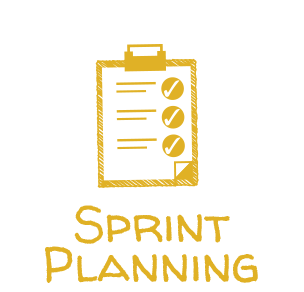 This session is the heartbeat of the iterative process at the team level.
This session is the heartbeat of the iterative process at the team level.
The objective is to decide upon what will be delivered in the next iteration (if you’re using Scrum). Kanban teams who do not run in Sprints tend to pull from the top of the backlog as new items and priorities arise, but in many cases can also benefit from planning on a cadence of their choosing for work suitable for forward planning and to discuss capacity allocation.
- Values & Goals
- Do I have too much work?
- Do I know what I have to do?
- Product & Impact
- Prioritized sprint backlog
- Select stories to work on
- Team pulls the work
- Story task plan
- Achievable sprint plan
- Leadership & Culture
- Sprint Goal
- External team collaboration
- Effective communication
- Team commitment to sprint plan
- Markets & Environment
- Capacity planning
- Resources are available
Daily Stand Up
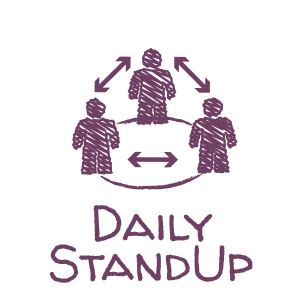 The main purpose of this meeting is to coordinate team efforts towards the iteration goal. Best practices suggest a brief (15 minute) meeting with anything outside the scope of daily coordination to be taken offline by the Scrum Master.
The main purpose of this meeting is to coordinate team efforts towards the iteration goal. Best practices suggest a brief (15 minute) meeting with anything outside the scope of daily coordination to be taken offline by the Scrum Master.
Examples of topics to be taken offline include:
- Design considerations (technical or product related)
- Strategy regarding removal of impediments
- Coordination with other teams
- Values & Goals
- What am I planning to do today?
- Do I feel confident about my work?
- Active listening
- Product & Impact
- What did I do yesterday?
- Discuss impediments
- Check burn down chart
- Completion of work
- Update task plan
- Leadership & Culture
- Am I fully present?
- Ask for help
- Provide updates
- Taking things offline (planning to meet later)
- Coordination to achieve sprint goal
- Markets & Environment
- Blocks/issues to resolve
- Update the Sprint plan
Backlog Refinement
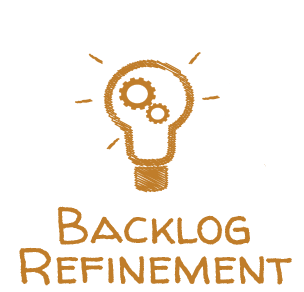 This session ensures the team will be able to deliver the right things, at the right time, without getting blocked. The team and Product owner meet regularly to maintain a Detailed, Estimated, Emergent, and Prioritized backlog that meets a team’s Definition of READY, which is key to enabling the efficient creation of valuable products that delight customers.
This session ensures the team will be able to deliver the right things, at the right time, without getting blocked. The team and Product owner meet regularly to maintain a Detailed, Estimated, Emergent, and Prioritized backlog that meets a team’s Definition of READY, which is key to enabling the efficient creation of valuable products that delight customers.
Benefits of a healthy backlog include:
- Reduction of defects/improved quality
- Reduction of re-work
- The highest priority items get to the customer sooner
- Values & Goals
- Empowered Product Owner
- Engineer understands User Story
- Product & Impact
- Engaged Product Owner
- Prioritize Backlog
- Establish Planning Horizon
- Choose stories to refine
- Leadership & Culture
- Aligned to Product Vision
- Connected with the customer
- Team helps refine stories
- Partnership between Product & Tech
- Markets & Environment
- Definition of READY
- Dependency resolution
Retrospective
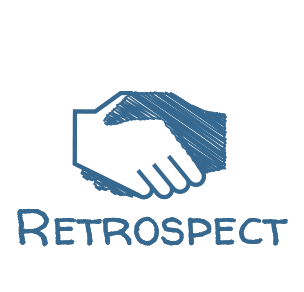 Continuous Improvement and the ability to adapt as things change is arguably the most important aspect of the Agile mindset. Retrospectives are open, honest sessions where team members, the Product Owner, and the Scrum Master share their experience of how the team is working together with ideas on how to better achieve their common goals.
Continuous Improvement and the ability to adapt as things change is arguably the most important aspect of the Agile mindset. Retrospectives are open, honest sessions where team members, the Product Owner, and the Scrum Master share their experience of how the team is working together with ideas on how to better achieve their common goals.
The Retrospective should NEVER be skipped due to time constraints, and should always result in a tangible improvement plan that will be assessed for follow-through and impact at the beginning of the next Retrospective.
- Values & Goals
- How do I feel about the last Sprint?
- Individual accountability
- What can I do differently?
- Product & Impact
- What went well?
- What didn’t go well?
- Improvement actions/items
- Measurement of improvement impact
- Leadership & Culture
- What can we do differently?
- Open and honest intent
- Markets & Environment
- Team celebration choice/venue
Sprint Review
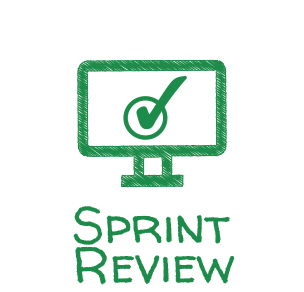 The Sprint Review occurs at the end of each small iterative cycle. Its main purpose is to solicit feedback so the team can remain focused on the goals as the landscape changes. Everyone benefits from taking a step back to celebrate the good work the whole team has done, and seeing the product emerge step by step builds engagement and a feeling of success for all participants.
The Sprint Review occurs at the end of each small iterative cycle. Its main purpose is to solicit feedback so the team can remain focused on the goals as the landscape changes. Everyone benefits from taking a step back to celebrate the good work the whole team has done, and seeing the product emerge step by step builds engagement and a feeling of success for all participants.
- Values & Goals
- Speak to MY work
- Pride in my accomplishments
- Product & Impact
- Delivery of value/impact
- View of the emerging product
- Tracking towards business goals
- Leadership & Culture
- Customer/user feedback
- Team feedback
- Course correction (Priority & Learning)
- Markets & Environment
- Organizational/systemic learning
- Systemic value delivery



